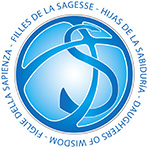The Chronicles of Sister Florence (1750-1761)
The chronicles of Sister Agathange, “official” chronicler of the Congregation
Caroline Nogues, Sister Agathange, was born in Lorient on September 5, 1791.

Page de titre du 2e volume des chroniques de Soeur Agathange (FDLS FA 2)
She spent three years in the prison of Mont Saint-Michel, then became successively second mistress of the novitiate at Saint-Laurent-sur-Sèvre (1821-1831), superior of the hospital at Pontorson (1832-1839), first mistress of novices at Saint-Laurent-sur-Sèvre (1839-1848), and finally, superior of the house of education in Rennes (1848-1851). Returning to Saint-Laurent in 1851, she was given the task of writing the chronicles of the Congregation; she continued her work until the eve of her death in 1873 (personal file preserved under the reference FDLS J 3-1).
Her chronicles in 12 manuscript volumes have been digitized (FDLS FA 1-FA 12). They cover the history of the Congregation “from the year 1701, the time of its foundation, to the present day (December 31, 1866).
Chronicles and Revolution, a recomposed history
Sister Agathange’s chronicles are particularly useful for finding information about the work of the Daughters of Wisdom during the Ancien Régime and the Revolutionary period, as few original documents from these periods have been preserved. Sister Agathange’s research is full of anecdotes that bring to life the daily life of the sisters during the difficult hours of the Revolution.
Thus, from 1790 to 1800, the community of Brest became the refuge and “headquarters” of the Congregation. Already serving the hospital in Brest since 1777, the sisters managed the supplies for the hospital of the Navy from 1784 on. On October 23, 1789, they also “agreed” to take charge of the care and remedies.
However, as early as 1790, the nuns suffered the first persecutions linked to the Revolution and to the opposition of the population: searches of their apartments, arson, etc. The pharmacists of the city did not want them to be killed. The pharmacists of the city accused them of not having the qualities required to practice their profession and “some individuals from Brest” demanded the government of the hospital (FDLS FA 2, vol. 2, p. 623-658). They even went so far as to hide Father Duchesne, Superior General of the Montfortians, who was forced to disguise himself by wearing their costume and several aliases (Sister Saint-Lazare and then Sister Saint-Méen).
They agreed to conceal their religious insignia and to change their costume (September 17, 1792), but refused to take the oath since the law did not oblige them to do so (FDLS FA 2, vol. 2, p. 694). In 1794, the Revolutionary Committee set up shop in the hospital in Brest and those condemned to death were taken to be tortured in the cart they used for the hospital (FDLS FA 2, vol. 2, p. 806).
These few significant facts show the interest of the chronicles which are precious sources to testify to the relations developed between the superiors of the Congregation and the civil or religious authorities.
Close to the authorities of the Congregation, Sister Florence and Sister Agathange were privileged witnesses of its evolution. They have left an invaluable source for tracing the history of the Institute.
Other sisters, who remained anonymous, continued their work.
In all, 20 volumes of chronicles, from 1701 to 1913, can be consulted in the inventory: Congregation of the Daughters of Wisdom – Administration, members of the congregation and history of the establishments run by the sisters. A presentation (for the first three) and tables of contents for the following ones (searchable in full text) facilitate research. |








